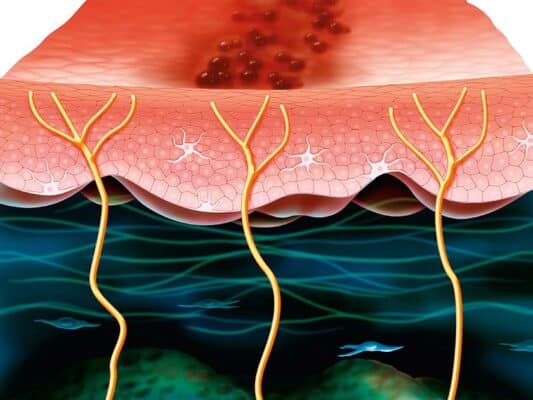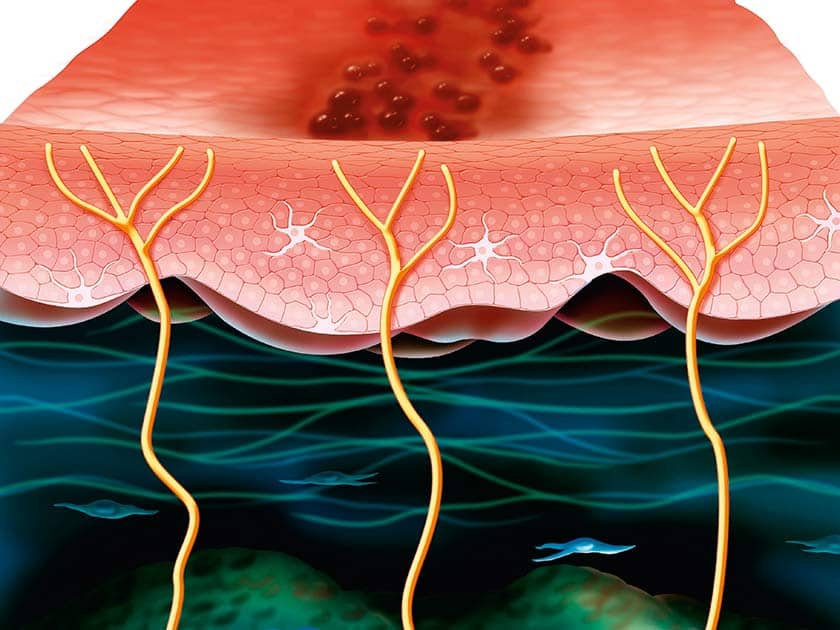The Varicella-Zoster virus is the source of shingles, so Herpes Zoster and Zoster are alternative names for the infection. Varicella-Zoster is also responsible for chickenpox hence the relationship between chickenpox and Zoster. People who have not had chickenpox do not develop Herpes Zoster. Not everyone who has had chickenpox will experience an outbreak of Herpes Zoster.
Lying in Wait
Typically, chickenpox comes under the heading of childhood disease, but it affects adults as well. After someone recovers from chickenpox, the Varicella-Zoster virus hibernates in their body. Decades can pass before the virus awakens and becomes a Herpes Zoster infection. Medical researchers have yet to learn why the virus will resurrect in some but not others. There are known Herpes Zoster risk factors.
The Risk Factors
First Stage Symptoms
The first sign that the Varicella-Zoster virus has awakened is localized skin pain. The discomfort presents as burning, extra-sensitive to touch, tingling, or itching. The early symptoms occur because the virus attaches itself to the nerves. Other signs of a viral infection can accompany the pain that marks the onset of Zoster. Those symptoms include chills, fatigue, fever, headache, and nausea.
Second Stage Symptoms
Within 2-14 days of the onset of symptoms, a rash, or exanthem in medical terms, develops in the area affected by the skin discomfort.
The Zoster Rash
The Zoster rash is red. Fluid-filled vesicles (blisters) accompany the rash. A Greek word for girdle is the source of the zoster in Varicella-Zoster. The Herpes Zoster rash forms rectangular clusters. Depending on the location, the exanthem can wrap around the affected area in a spiral configuration. Generally, the infection is centralized to a single area of the body.
- Back
- Waist
- Breast
- Stomach
The rash also forms on the buttocks, face, and neck. The arms and legs may also be affected. There is a remote possibility of a breakout on two or more of the areas listed above. In a week to 10 days, the vesicles will dry-out, leaving scabs.
Zoster Dont’s
A person who is tempted to break the Herpes Zoster blisters should leave them alone. The fluid inside the vesicles contains the Varicella-Zoster virus. Rupturing them causes the infection to spread and can result in permanent scarring. In two weeks to a month, when the blisters become scabs allow them to fall off on their own. Do not remove the scabbing yourself.
Treatments
People in the at-risk groups mentioned earlier need to seek medical attention at the first sign of an outbreak. A Herpes Zoster rash that develops around the eye demands immediate medical attention. A healthcare provider will likely prescribe an anti-viral medication to keep the infection in check. Depending on the severity, opioid usage manages Zoster-related pain. Those who prefer a homeopathic pain treatment might consider a topical shingles cream.

A good topical shingles cream and an alternative to opioids would be a homeopathic cream containing natural ingredients, which help to ease discomfort from several causes, including nerve pain.
The Vaccine
The Center for Disease Control guidelines recommends inoculation against Herpes Zoster for anyone over 60 with the following exceptions.
- The presence of leukemia or lymphoma
- Ongoing cancer treatment
- A compromised immune system
- If the patient has untreated tuberculosis
- Sensitivity to the vaccines ingredients
Consult your medical practitioner about receiving the Herpes Zoster vaccine. The CDC states that vaccination is 90% effective in preventing Zoster.
Additional Information
Having had Zoster once does not create immunity against future Varicella-Zoster virus infections. It is possible to experience multiple Herpes Zoster outbreaks. Zoster is communicable. There is no risk of spreading Zoster before the rash appears or after it has crusted over.
The Answer is Yes
Now we come to the answer to our title query, “Is Shingles a Serious Skin Condition?” Considering the possible long-term consequences caused by Zoster, the answer would have to be yes. Especially when Zoster affects the face and head,
Effects on The Eyes
Herpes Zoster can cause glaucoma. Damage to the optic nerve caused by the infection creates the possibility of permanently impaired vision and blindness.
The Effect on The Ears
If the exanthem occurs in the area of the ear, Ramsay Hunt Syndrome (RHS) can develop. The symptoms of RHS are ringing in the ears and impaired balance. In the worst-case, Ramsay Hunt results in facial paralysis or permanent deafness.
Effects on The Nerves
Postherpetic neuralgia (PHN) is when the nerve pain continues after the infection has cleared. PHN related discomfort can last for months or the rest of the patient’s life.
The symptoms of Herpes Zoster are nerve pain and a blistering rash. Seek medical intervention with the first symptoms. Breaking open the vesicles creates the risk of a broader infection. Zoster can cause permanent damage to the eyes, ears, and nerves. The Herpes Zoster vaccine is 90% effective.

